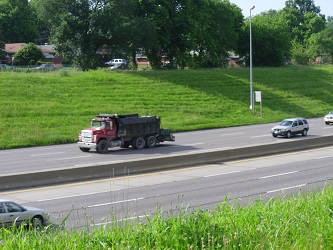Significance of Community Edges
by Jen

A Severe Type of Neighborhood Edge
Reviewed: June 12, 2024
Visitor Question: I wonder about whether the term edge or community edge is really important. I hear this discussed sometimes when I attend various citizen planner meetings. I have been cycling on and off our local planning commission and recently was appointed to a regional planning board.
My first question is whether you can speak to the meaning of these terms. Second, do you think it is important that such an edge be maintained? Why or why not?
Editors Respond: There are at least two ways that the term edge is currently used in urban planning circles. The first one represents a theoretical boundary or division between the urbanized, built-up area and the beginning of the rural or semi-rural area. If you are asking in your role as a regional citizen planner whether we think that type of edge is important and should be maintained, the answer is an emphatic yes.
For our reasoning, please see our pages on an introduction to urban sprawl and the effects of urban sprawl. We have written so much in this whole section of our site that we think it would be best to refer you there rather than add more commentary.
On a related note, sometimes people use the term edge or urban edge to refer to the parts of the urban area that are furthest from the center. This usage became somewhat common after the publication of the influential 1991 book on what author Joel Garreau called Edge Cities, by which he meant newly created urban employment centers on the outskirts of the previously developed urban area near major highways or sometimes in formerly residential areas. We are ignoring that usage elsewhere in our answer, but wanted you to be aware of it.
To add new insights to our site while answering your question, we want to concentrate on a second use of the term "edge," a meaning that has been popular in urban design and planning for at least several decades. This meaning refers to edges within the built-up area of the city or town.
For readers who don't have a clue what we're talking about, an edge could be described as a linear feature of a city that subjectively divides the city into sections or districts. Usually it's valid to think of an edge as a boundary, or a definite line of demarcation of a district, neighborhood, or just design character.
When we say boundary, we don't mean an arbitrary line that someone has drawn. We mean an organic boundary between two different types of places. The edge may or may not coincide with a political, legal, or planning boundary.
Generally speaking, we think good edges, defined in the sense of organically occurring boundaries, tend to make good neighbors and ultimately good cities. Exceptions will be noted below. As Kevin Lynch described them in the classic but still valid book The Image of the City first printed in 1960, edges are one of the ways people navigate and understand their cities. Some strong edges, such as shorelines, railroad cuts, or the old Roman walls, are pivotal in our internal maps of our cities.
An edge may be impenetrable (such as a shoreline or a wall around a gated community), difficult to cross (for example, interstate highways), or easy to penetrate (for instance, areas divided only by a narrow street). To complicate matters further, a feature such as an elevated highway may actually be quite easy to cross by way of an at-grade underpass, but may still represent a strong psychological barrier.
Visually strong, continuous, and well-understood edges also usually define a district or neighborhood as a well-developed entity. We do think that neighborhood boundaries that are easy to comprehend help that neighborhood achieve city-wide recognition, which is important as a neighborhood marketing tool. Such clear boundaries also help residents, especially renters and newer residents, understand and identify with the neighborhood.
Of course if a neighborhood has an absolutely terrible reputation, those well-understood boundaries can be a liability, but those neighborhoods are numerically few.
This observation leads naturally to the point that some edges are perceived quite negatively. The Berlin Wall, wide interstate highways cutting off downtowns from neighborhoods or rivers, or industrial fences or walls that obscure our view of a waterfront are examples. Local history, the visual character of the edge, and even minority occupancy of a particular territory may mean that an edge is perceived as a signal to keep out or that the edge only dramatizes an existing conflict.
The photo we added to your question (hope you don't mind) dramatizes how a severe looking edge dividing two neighborhoods may not be the best feature of your community.
To begin to answer your second question, we do think that strong, unambiguous edges are important ways that people subjectively understand their communities, but we think the edge can play a positive or negative role in the community depending on its visual attractiveness, the meaning that the locals ascribe to it, and whether the edge leaves some neighborhoods or potentially attractive districts isolated from the main flow of the city.
So whether or not it is important to maintain this second type of edge depends on whether the role it plays in your community is a positive or negative one. Tearing down the Berlin Wall and beginning to knit east and west back together seems to us to be enormously positive, but if you blur the traditional boundaries of your neighborhood to such a point that people no longer recognize where and what your neighborhood is, we call that a negative.
- A Good Community >
- Questions >
- Planning Terms > Community Edges
Join GOOD COMMUNITY PLUS, which provides you monthly with short features or tips about timely topics for neighborhoods, towns and cities, community organizations, and rural or small town environments. Unsubscribe any time. Give it a try.